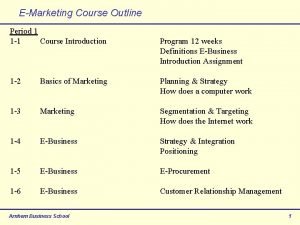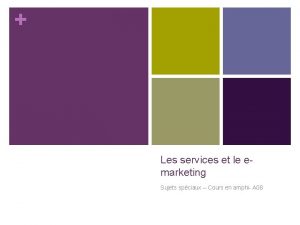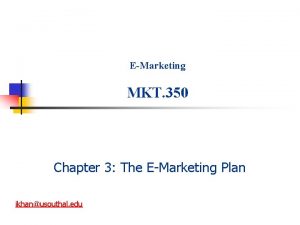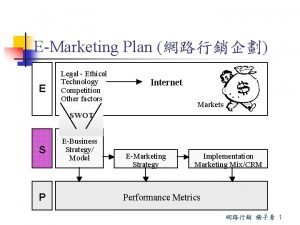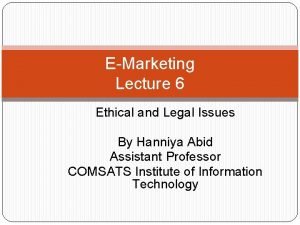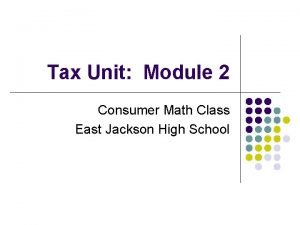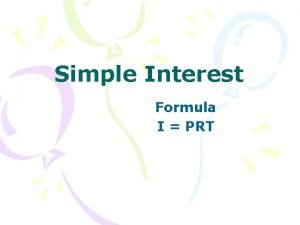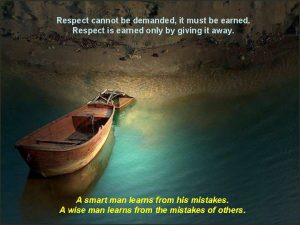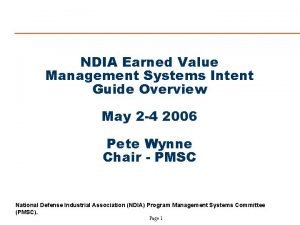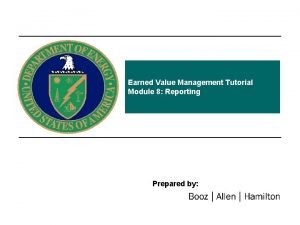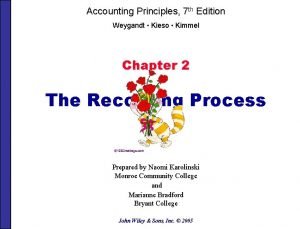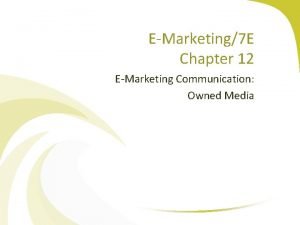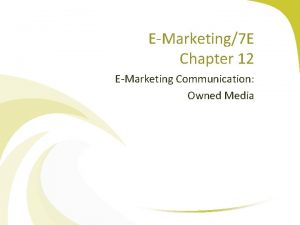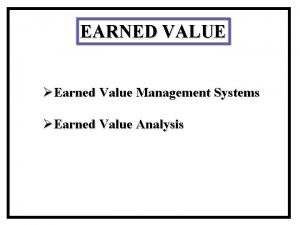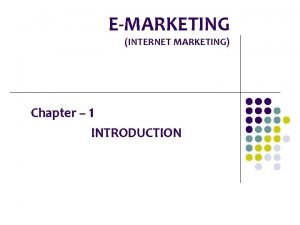EMarketing7 E Chapter 14 EMarketing Communication Earned Media





















- Slides: 21

E-Marketing/7 E Chapter 14 E-Marketing Communication: Earned Media

Chapter 14 Objectives • After reading Chapter 14, you will be able to: – Describe the five levels of user engagement and explain what each means for earned media. – Explain the role of trust in earned media and its implications for consumer behavior. – List some key techniques for engaging users and discuss the importance of each. – Outline the marketing benefits of engaging consumers in collaborative content creation. © 2014 Pearson Education, Inc. publishing as Prentice Hall 14 -2

Chapter 14 Objectives, cont. – Highlight seven ways in which companies can attract users and move them up the engagement ladder. – Discuss how a company can build, maintain, monitor, and repair its reputation online. – Identify specific metrics used to monitor, measure, and refine earned media activities. © 2014 Pearson Education, Inc. publishing as Prentice Hall 14 -3

Dell Starts Listening • A blog post about Dell Computer brought a hailstorm of customer service complaints that lasted for nearly 2 years. – The blogger complained that a laptop and its in-home service he purchased from Dell were inadequate. – The complaint followed Dell’s decision to outsource technical customer service to India, a move which also generated many negative comments. • When the complaints didn’t stop, Dell appointed a media manager to deal with internet chatter who initiated blogs in multiple languages to handle complaints and ideas. – The blog Idea. Storm gathered ideas and endorsements that resulted in numerous changes in the company. © 2014 Pearson Education, Inc. publishing as Prentice Hall 14 -4

Earned Media • Earned media are like physical word-of-mouth on steroids: a social megaphone. – Can be initiated by the company through branded content, news sites, and press releases. – Companies have little to no control over usergenerated content (UGC). © 2014 Pearson Education, Inc. publishing as Prentice Hall 14 -5

• Engagement occurs among and between the company and internet users, who are actively discussing the brand. • There are many levels of user engagement online. Engagement Level User Engagement Levels © 2014 Pearson Education, Inc. publishing as Prentice Hall 14 -6

User Engagement Levels, cont. • Least engaged users consume only online content. • At the next level, users connect with others by creating a profile on a social network, such as by “friending” on Facebook. • Consumers who collect information filter content and tag what they find valuable in social media sites. • Creators write or upload original content. • The most engaged customers collaborate with the company when they engage in discussions to improve products. © 2014 Pearson Education, Inc. publishing as Prentice Hall 14 -7

Social Media Influencers and Traditional Journalists • Companies identify social media influencers by observing and participating in social media discussions. • They can also find influentials by using a service such as Klout. com. • Companies often include press releases about their brands on their Web sites and send them to media firms for publishing. © 2014 Pearson Education, Inc. publishing as Prentice Hall 14 -8

Social Media Friendly Press Release © 2014 Pearson Education, Inc. publishing as Prentice Hall 14 -9

Techniques for Engaging Users • Successful viral marketing programs involve appealing content that has a high chance of spreading. – Few companies can create content that goes viral, although Old Spice is credited with the fastest-growing online viral video campaign. – Viral blogging via Twitter can also be effective. © 2014 Pearson Education, Inc. publishing as Prentice Hall 14 -10

Techniques for Engaging Users, cont. • Multimedia sharing of photos, art, video, and music can generate online discussion. • Wikis, Web sites that allow users to post, edit, and organize content, as well as online ratings and reviews can also be effective tools for engaging online users. © 2014 Pearson Education, Inc. publishing as Prentice Hall 14 -11

Social Recommendations & Referrals • Social bookmarking sites allow users to share their favorite Web sites and comments. – Stumble. Upon. com – Delicious. com • Referral programs involve rewards for customers who refer new customers. – Groupon – Gilt • Marketers can integrate email with social media. – Yahoo!, Gmail and Outlook allow integration with Facebook contacts. © 2014 Pearson Education, Inc. publishing as Prentice Hall 14 -12

Groupon Encourages E-Mail © 2014 Pearson Education, Inc. publishing as Prentice Hall 14 -13

Converting Facebook Fans to Customers 10 Reasons Brands Fail to Convert Facebook Fans into Paying Customers 1. Failure to Get Past the First Step (try to engage visitors immediately) 2. Poor Text and Visuals (must be relevant to brand visitors) 3. Stagnant Page Content (use consistent fresh content) 4. Inconsistent or Sloppy Branding (Facebook page and Web site with consistent brand elements) 5. Confused Calls-to-Action (make clear offers on Facebook) 6. Too Many Clicks (create only a few clicks to target content) 7. Mystery Visitors (compile Facebook user profiles) 8. Preconceived Notions (use Facebook specific campaigns) 9. Ineffective Plugin Use (integrate “like” buttons, recommendation and comment boxes well) 10. Sticking to Stand-alone Metrics (integrate Facebook with other shopping stats) © 2014 Pearson Education, Inc. publishing as Prentice Hall 14 -14

Widgets • Widgets can include brand information in contests or games. • Companies such as Friend 2 Friend and Product Pulse create widgets for advertisers that allow voting, gaming, and gifting. © 2014 Pearson Education, Inc. publishing as Prentice Hall 14 -15

Social Apps • Facebook features thousands of software apps on its site that engage users. – Facebook messenger allows users to send messages to mobile phones. – Instagram allows users to take photos and share them on Facebook, Twitter, and Tumblr. © 2014 Pearson Education, Inc. publishing as Prentice Hall 14 -16

Location-Based Services (LBS) • LBS is a business model for m-commerce. • There are several major players. – Foursquare works via a smartphone app on its mobile Web site. – Yelp published 33 million reviews of local businesses in 2012. – Facebook places can add a location to Facebook text-based or photo posts. © 2014 Pearson Education, Inc. publishing as Prentice Hall 14 -17

How Do Companies Entice Engagement? • Provide high-quality, timely, unique, and relevant information. • Create entertaining content. • Offer competitions. • Appeal to altruism. • Make an exclusive offer. • Reward influentials and fans. • Incentivize group behavior. © 2014 Pearson Education, Inc. publishing as Prentice Hall 14 -18

Reputation Management Online • With earned media, there are many opportunities for other people to shape the reputations of a company, its brand, and employees. • According to PR firm Weber Shandwick, 63% of a company’s market value is attributable to reputation. • The reputation management process includes 4 steps: – Build – Maintain – Monitor – Repair © 2014 Pearson Education, Inc. publishing as Prentice Hall 14 -19

Earned Media Performance Metrics • In addition to metrics such as number of likes and shares on company-owned channels, there a number of metrics that can be applied to earned media. – General earned media metrics: number of users who interact with an application, time spent viewing a video, social media fan growth, etc. – Actions taken by users: Number of downloads of a white paper, ring tones, number of games played, polls voted, etc. – Conversations on blogs and elsewhere: Tweets/retweets, positive/negative comments, etc. © 2014 Pearson Education, Inc. publishing as Prentice Hall 14 -20

All rights reserved. No part of this publication may be reproduced, stored in a retrieval system, or transmitted, in any form or by any means, electronic, mechanical, photocopying, recording, or otherwise, without the prior written permission of the publisher. Printed in the United States of America. Copyright © 2014 Pearson Education, Inc. Publishing as Prentice Hall 14 -21
 E-marketing plan
E-marketing plan Emarketing system
Emarketing system Emarketing plan
Emarketing plan 6 i's of marketing
6 i's of marketing Cours emarketing
Cours emarketing Venture capital e marketing plan
Venture capital e marketing plan Emarketing plan
Emarketing plan Legal emarketing
Legal emarketing Legal emarketing
Legal emarketing Tips earned by a server in a fashionable restaurant
Tips earned by a server in a fashionable restaurant Prt=i
Prt=i Respect cannot be demanded it must be earned
Respect cannot be demanded it must be earned Earned value management systems eia-748-c intent guide
Earned value management systems eia-748-c intent guide Ms project earned value management systems
Ms project earned value management systems What is parallel structure
What is parallel structure Times-interest-earned ratio
Times-interest-earned ratio Earned value management tutorial module 7
Earned value management tutorial module 7 Spi acronym project management
Spi acronym project management Horizontal analysis example
Horizontal analysis example Cash realization ratio
Cash realization ratio Ariba implementation at med-x
Ariba implementation at med-x Withdraw cash for personal use journal entry
Withdraw cash for personal use journal entry



